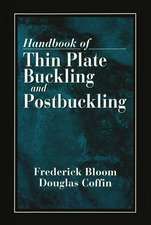Fast Radial Basis Functions for Engineering Applications
Autor Marco Evangelos Biancolinien Limba Engleză Hardback – 16 apr 2018
Radial basis functions (RBF) are a mathematical tool mature enough for useful engineering applications. Their mathematical foundation is well established and the tool has proven to be effective in many fields, as the mathematical framework can be adapted in several ways. A candidate application can be faced considering the features of RBF:
multidimensional space (including 2D and 3D), numerous radial functions available, global and compact support, interpolation/regression.
This great flexibility makes RBF attractive – and their great potential has only been partially discovered. This is because of the difficulty in taking a first step toward RBF as they are not commonly part of engineers’ cultural background, but also due to the numerical complexity of RBF problems that scales up very quickly with the number of RBF centers. Fast RBF algorithms are available to alleviate this and high-performance computing (HPC) can provide further aid. Nevertheless, a consolidated tradition in using RBF in engineering applications is still missing and the beginner can be confused by the literature, which in many cases is presented with language and symbolisms familiar to mathematicians but which can be cryptic for engineers.The book is divided in two main sections. The first covers the foundations of RBF, the tools available for their quick implementation and guidelines for facing new challenges; the second part is a collection of practical RBF applications in engineering, covering several topics, including response surface interpolation in n-dimensional spaces, mapping of magnetic loads, mapping of pressure loads, up-scaling of flow fields, stress/strain analysis by experimental displacement fields, implicit surfaces, mesh to cad deformation, mesh morphing for crack propagation in 3D, ice and snow accretion using computational fluid dynamics (CFD) data, shape optimization for external aerodynamics, and use of adjoint data for surface sculpting. For each application, the complete path is clearly and consistently exposed using the systematic approach defined in the first section.
| Toate formatele și edițiile | Preț | Express |
|---|---|---|
| Paperback (1) | 692.69 lei 39-44 zile | |
| Springer International Publishing – 11 dec 2018 | 692.69 lei 39-44 zile | |
| Hardback (1) | 791.78 lei 6-8 săpt. | |
| Springer International Publishing – 16 apr 2018 | 791.78 lei 6-8 săpt. |
Preț: 791.78 lei
Preț vechi: 965.59 lei
-18% Nou
Puncte Express: 1188
Preț estimativ în valută:
151.51€ • 165.24$ • 127.75£
151.51€ • 165.24$ • 127.75£
Carte tipărită la comandă
Livrare economică 24 aprilie-08 mai
Preluare comenzi: 021 569.72.76
Specificații
ISBN-13: 9783319750095
ISBN-10: 3319750097
Pagini: 200
Ilustrații: XIV, 358 p. 316 illus.
Dimensiuni: 155 x 235 mm
Greutate: 0.72 kg
Ediția:1st ed. 2017
Editura: Springer International Publishing
Colecția Springer
Locul publicării:Cham, Switzerland
ISBN-10: 3319750097
Pagini: 200
Ilustrații: XIV, 358 p. 316 illus.
Dimensiuni: 155 x 235 mm
Greutate: 0.72 kg
Ediția:1st ed. 2017
Editura: Springer International Publishing
Colecția Springer
Locul publicării:Cham, Switzerland
Cuprins
Introduction.- Fast RBF for Engineering Applications.- Radial Basis Functions.- RBF Tools.- Can I Benefit of RBF? Guidelines.- Examples.- A CFD Shape Optimization Approach Based on Mesh Morphing and RBF Response Surface Method.- Radial Basis Functions for the Interpolation of Hemodynamics Flow Pattern: A Quantitative Analysis.- Radial Basis Functions for the Image Analysis of Deformations.- A New Workflow for Patient Specific Image-based Hemodynamics: Parametric Study of the Carotid Bifurcation.- Conclusions.
Recenzii
“The key feature of the research is using radial basis approximations for scattered data to construct a structuring surface mesh and applying it for solving a lot of industry problems. All in all, the book is a good reference for applications of radial basis functions in industry.” (Zongmin Wu, zbMATH 1408.65002, 2019)
“This very interesting book contains the Radical Basis Function (RBF) Method and its main and recent applications. … I recommend the book to RBF mathematical foundation experts, who can find in it many interesting engineering applications of the method, and to engineers and scientists who have yet to discover thispowerful tool.” (Alessandra De Rossi, Mathematical Reviews, February, 2019)
“This very interesting book contains the Radical Basis Function (RBF) Method and its main and recent applications. … I recommend the book to RBF mathematical foundation experts, who can find in it many interesting engineering applications of the method, and to engineers and scientists who have yet to discover thispowerful tool.” (Alessandra De Rossi, Mathematical Reviews, February, 2019)
Textul de pe ultima copertă
This book presents the first “How To” guide to the use of radial basis functions (RBF). It provides a clear vision of their potential, an overview of ready-for-use computational tools and precise guidelines to implement new engineering applications of RBF.
Radial basis functions (RBF) are a mathematical tool mature enough for useful engineering applications. Their mathematical foundation is well established and the tool has proven to be effective in many fields, as the mathematical framework can be adapted in several ways. A candidate application can be faced considering the features of RBF:
multidimensional space (including 2D and 3D), numerous radial functions available, global and compact support, interpolation/regression.
This great flexibility makes RBF attractive – and their great potential has only been partially discovered. This is because of the difficulty in taking a first step toward RBF as they are not commonly part of engineers’ cultural background, but also due to the numerical complexity of RBF problems that scales up very quickly with the number of RBF centers. Fast RBF algorithms are available to alleviate this and high-performance computing (HPC) can provide further aid. Nevertheless, a consolidated tradition in using RBF in engineering applications is still missing and the beginner can be confused by the literature, which in many cases is presented with language and symbolisms familiar to mathematicians but which can be cryptic for engineers.The book is divided in two main sections. The first covers the foundations of RBF, the tools available for their quick implementation and guidelines for facing new challenges; the second part is a collection of practical RBF applications in engineering, covering several topics, including response surface interpolation in n-dimensional spaces, mapping of magnetic loads, mapping of pressure loads, up-scaling of flow fields, stress/strain analysis by experimental displacement fields, implicit surfaces, mesh to cad deformation, mesh morphing for crack propagation in 3D, ice and snow accretion using computational fluid dynamics (CFD) data, shape optimization for external aerodynamics, and use of adjoint data for surface sculpting. For each application, the complete path is clearly and consistently exposed using the systematic approach defined in the first section.
Radial basis functions (RBF) are a mathematical tool mature enough for useful engineering applications. Their mathematical foundation is well established and the tool has proven to be effective in many fields, as the mathematical framework can be adapted in several ways. A candidate application can be faced considering the features of RBF:
multidimensional space (including 2D and 3D), numerous radial functions available, global and compact support, interpolation/regression.
This great flexibility makes RBF attractive – and their great potential has only been partially discovered. This is because of the difficulty in taking a first step toward RBF as they are not commonly part of engineers’ cultural background, but also due to the numerical complexity of RBF problems that scales up very quickly with the number of RBF centers. Fast RBF algorithms are available to alleviate this and high-performance computing (HPC) can provide further aid. Nevertheless, a consolidated tradition in using RBF in engineering applications is still missing and the beginner can be confused by the literature, which in many cases is presented with language and symbolisms familiar to mathematicians but which can be cryptic for engineers.The book is divided in two main sections. The first covers the foundations of RBF, the tools available for their quick implementation and guidelines for facing new challenges; the second part is a collection of practical RBF applications in engineering, covering several topics, including response surface interpolation in n-dimensional spaces, mapping of magnetic loads, mapping of pressure loads, up-scaling of flow fields, stress/strain analysis by experimental displacement fields, implicit surfaces, mesh to cad deformation, mesh morphing for crack propagation in 3D, ice and snow accretion using computational fluid dynamics (CFD) data, shape optimization for external aerodynamics, and use of adjoint data for surface sculpting. For each application, the complete path is clearly and consistently exposed using the systematic approach defined in the first section.
Caracteristici
Presents the first "How To" guide for a quick use of Radial Basis Functions in Engineering Applications Presents a "Formula 1 powered" approach used by the author to assisttop racing teams Demonstrates 12 different engineering applications in full Includes software and worksheets to be readily useful and productive





















